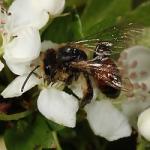Recent opinion considers this species as a synonym of Andrena rosae.
Southern England, with an apparent bias to Devon (particularly Dartmoor) and Dorset. The majority of records are about sixty years old.The most recent is a male collected at Hartland Quay, north Devon, on April 11 1988 by M R Oates.There are three Irish records, all from Carlow:Tinnahinch, May 4 1925, R A Phillips (Stelfox 1927); Kilcarry Bridge, Carlow, April 17 1930, A W Stelfox (Stelfox 1927); Kilcarry, April 22 1930, and Kilcarry Bridge, the next day, both A W Stelfox (both BMNH). Published records not supported by dates should be treated with care owing to possible confusion with this bee’s sibling species, A. rosae.The male typically has tergites 2-4 broadly marked with bright red. However, an entirely black form of the male of A. stragulata was reported from Devon by R C L Perkins (1919). The European distribution of this species is not known (see comments for A. rosae).
In common with its close relative, A. rosae, this bee has previously not been regarded as being scarce or threatened but, in view of the paucity of records (most of which are not recent), the status should be revised.
Little information is available. Specimens from Dartmoor, Devon, were observed on open moorland (Perkins 1943) and those from Vale Down, Lydford, Devon, were collected at an altitude of about 300 m. (BMNH).
Univoltine, late March to the end of May.
There is no information on nests of this species in the British Isles.
Blackthorn and willows.
None have been reported.
2009


